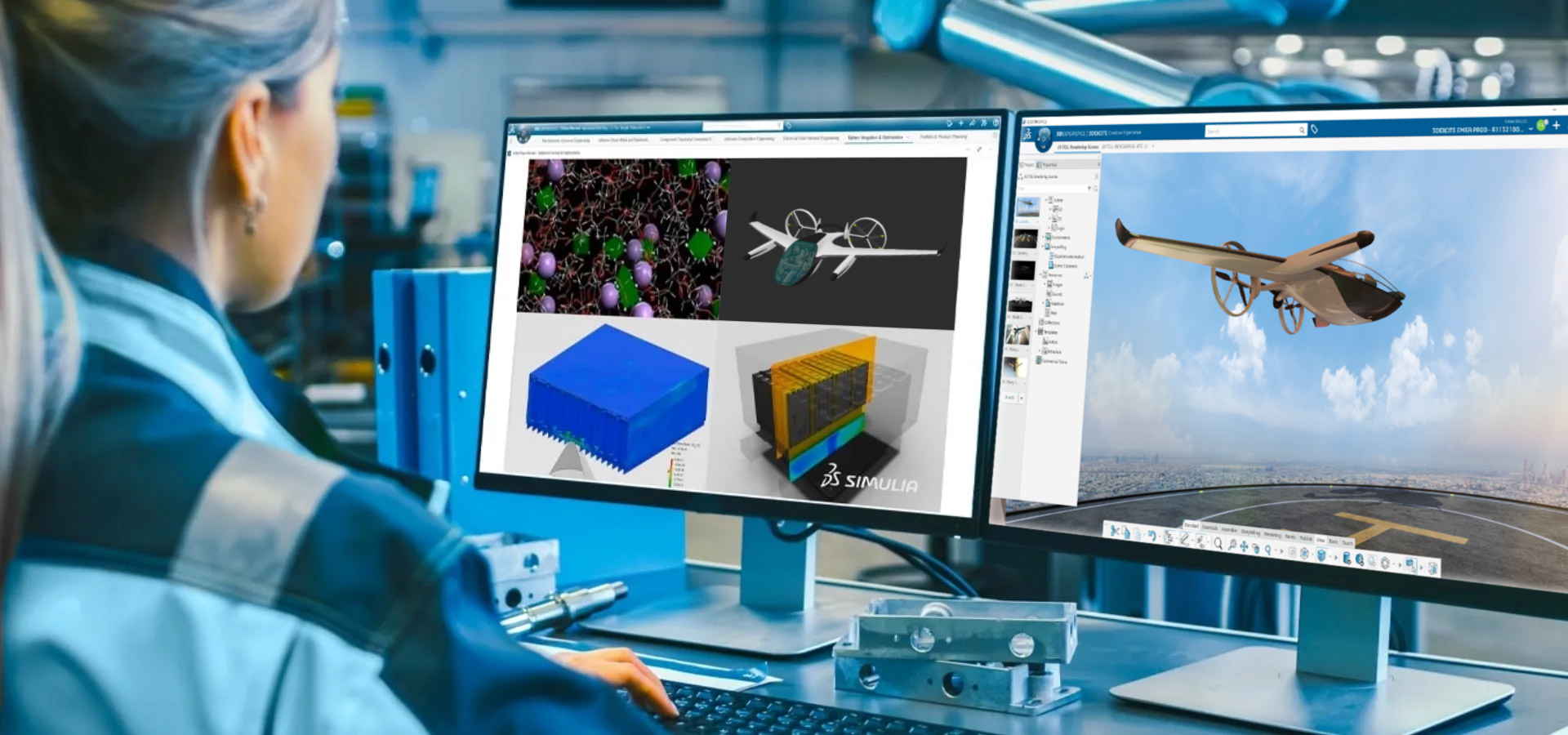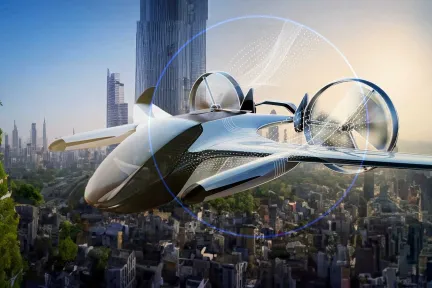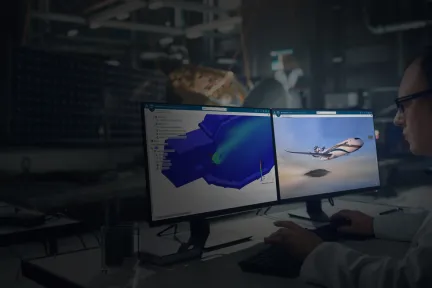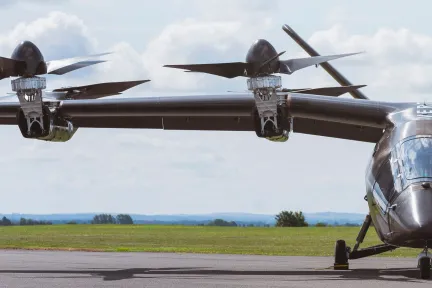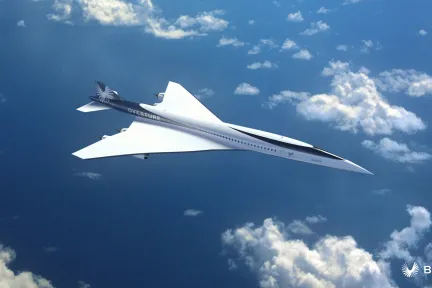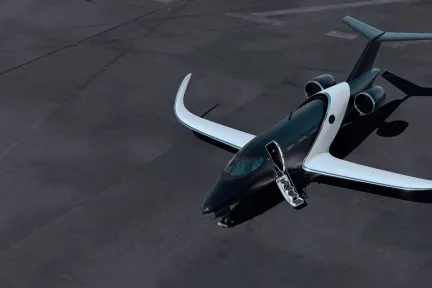Achieve Sustainability through Innovation
The Sky-High Route to Low-Carbon Aviation
Optimize low-carbon aircraft innovations and decarbonize your value chain from end to end with the Virtual Twin Experience on a single integrated platform.
Breakthrough Technologies in Aerospace
As the aerospace and defense industry propels towards a future defined by sustainability and efficiency, several key technologies are setting the stage for transformative advancements. Reusable launchers are revolutionizing space travel by dramatically reducing the costs and environmental impact of missions. In parallel, the development of electric and hydrogen-powered aircraft promises to usher in a new era of clean, efficient flight. Satellite constellations are expanding our capabilities in global communication and data analysis, proving indispensable in our interconnected world. Furthermore, investment in R&D for hypersonic technology is accelerating, potentially shrinking air travel times with speeds previously unimaginable. At the forefront of these innovations are advanced materials, which are crucial for enhancing the safety and performance of next-generation aircraft. These materials not only improve the longevity and durability of aerospace components but also play a pivotal role in achieving greater fuel efficiency and reducing the overall carbon footprint. Together, these developments represent the pinnacle of modern aerospace engineering, blending cutting-edge science with strategic market insights to redefine what is possible in air and space travel.
How Aerospace Innovations Benefit Society and the Environment
Sustainability has become essential in the Age of Experience. Half a century ago, the aviation industry prioritized speed with large, multi-engine aircraft that consumed substantial fuel and emitted significant volumes of greenhouse gases. Today, this industry has pivoted towards sustainability and an economy focused on fuel efficiency. Despite these advances, progress towards global CO2 reduction targets remains insufficient. Companies are deepening their commitment to sustainable manufacturing, creating value for all stakeholders, and fostering a thriving business environment through the strategic integration of three foundational pillars:
People: The future workforce is empowered with advanced knowledge and engineering expertise to develop sustainable capabilities that drive aerospace innovations.
Planet: By optimizing global operations and minimizing waste, the industry crafts air travel experiences that adhere to stringent environmental guidelines.
Profit: Enhanced efficiency, productivity, and a faster time to market are achieved through sophisticated value network orchestration, ensuring maximized profits.
Current sustainability solutions in development encompass a mix of advanced technologies, including low-carbon sustainable aviation fuels. Major industry players are also exploring methods to completely phase out traditional hydrocarbon-based fuels in favor of a carbon-neutral approach. These initiatives are primarily concentrated on hydrogen, electric, and hybrid-electric propulsion systems for both light and large-scale demonstration aircraft, which represent the most significant advancements to date.
In terms of environmental impact, aerospace innovations play a critical role. Sustainable aviation technologies such as SAF (Sustainable Aviation Fuel), along with electric, hybrid, and hydrogen-powered aircraft, are pivotal in reducing the aerospace industry’s carbon footprint. Additionally, Earth Observation systems are crucial in monitoring climate change and ecological catastrophes, such as tsunamis and other natural disasters. These technologies not only enhance the safety and efficiency of air travel but also contribute significantly to global environmental monitoring and disaster response strategies.
Discover How Dassault Systèmes Accelerates the Development of Sustainable Transformative Innovations
The Role of AI and Automation in Aerospace
Artificial Intelligence (AI) is revolutionizing the aviation industry by transforming how companies approach design, maintenance, and operations. At Dassault Systèmes, we have pioneered AI applications in aerospace for over four decades, particularly through our work in Generative Design. This technique utilizes AI to harness the power of computer vision and big data analytics, effectively turning vast amounts of data into actionable knowledge and expertise. One of the standout applications of AI is in Predictive Maintenance, where AI algorithms analyze data from aircraft operations to predict when maintenance should be performed, thereby reducing downtime and increasing safety. Additionally, AI-driven Generative Design is used to optimize complex surfaces for aerospace components, enhancing their efficiency and performance. By automating these processes, AI not only improves accuracy but also accelerates the pace at which new and innovative designs are developed, cementing its role as a transformative force in the aerospace sector.
Spotlight on Sustainable Aerospace Solutions
Optimize global operations by meeting environmental regulations through EcoDesign
Efficiently manage resources, including the supply chain and maintenance; repair and overhaul, across the product lifecycle
Balance the customer needs and sustainability to create real value
Educate the workforce to enable a sustainable future
The Future of Aerospace Innovations
Creating sustainable experiences is a complex process, requiring a diversity of knowledge and know-how. It is about optimizing current operations by connecting the dots between people, ideas and data inside and outside a company.
The 3DEXPERIENCE® platform allows informed teams to seamlessly collaborate across the globe and integrate new technologies, products, & services. This can transform the innovation process by leveraging virtual environments to solve real world challenges. This also allows companies to optimize operations, drive efficiencies and predictive maintenance, and improve environmental performance throughout the system of work.
FAQ
Explore our Industry Solution Experiences
Learn how to deliver on economic, environmental and social promises:
